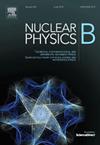Holographic superfluid sound modes with bulk acoustic black hole
IF 2.5
3区 物理与天体物理
Q2 PHYSICS, PARTICLES & FIELDS
引用次数: 0
Abstract
The sound modes of a flowing superfluid can be characterized by the massless Klein-Gordon equation in an effective background metric. This metric can be engineered to mimic a black hole by incorporating an acoustic horizon. In this study, we explore the AdS/CFT dual of sound modes within a fluid exhibiting an acoustic horizon in the bulk. Focusing on fluids with purely radial flow, we derive the effective metric for the acoustic spacetime and establish necessary conditions for the existence of an acoustic black hole geometry within the fluid. We examine two examples of acoustic black holes embedded in pure anti-de Sitter spacetime. For both examples, we compute the effective Hawking temperature associated with the bulk acoustic horizon and investigate the near-horizon properties. We then derive the superfluid velocity profile that may lead to infrared emergent quantum criticality. Our calculations reveal that although the superfluid is at zero temperature, the sound modes experience an effective nonzero temperature due to the presence of an acoustic horizon. We also calculate the retarded Green's function and the spectral density of the sound modes. Our findings reveal that the spectral density is gapless, while the retarded Green's functions display branch cuts rather than poles, a hallmark of strongly coupled systems. These calculations demonstrate how the behavior of sound modes in a fluid can deviate from that of the underlying scalar field, due to the deformation of the background metric into an effective one. Importantly, the detailed behavior of these modes in the presence of an acoustic horizon is contingent upon the specific fluid velocity profile.
体声黑洞全息超流体声模
流动超流体的声模式可以用有效背景度量中的无质量克莱因-戈登方程来描述。这种度量可以通过加入声学地平线来模拟黑洞。在这项研究中,我们探索了流体中声界的 AdS/CFT 声模对偶。针对纯径向流动的流体,我们推导出了声学时空的有效度量,并建立了流体中声学黑洞几何存在的必要条件。我们研究了两个嵌入纯反德西特时空中的声学黑洞的例子。对于这两个例子,我们都计算了与体声界相关的有效霍金温度,并研究了近界特性。然后,我们推导出可能导致红外突发量子临界的超流体速度曲线。我们的计算显示,虽然超流体的温度为零,但由于声学地平线的存在,声模经历了一个有效的非零温度。我们还计算了声模式的迟滞格林函数和频谱密度。我们的研究结果表明,频谱密度是无间隙的,而迟滞格林函数显示的是支切而不是极点,这是强耦合系统的一个特征。这些计算证明了流体中声模的行为如何会由于背景度量变形为有效度量而偏离底层标量场的行为。重要的是,这些模式在声场中的具体行为取决于特定的流体速度曲线。
本文章由计算机程序翻译,如有差异,请以英文原文为准。
求助全文
约1分钟内获得全文
求助全文
来源期刊

Nuclear Physics B
物理-物理:粒子与场物理
CiteScore
5.50
自引率
7.10%
发文量
302
审稿时长
1 months
期刊介绍:
Nuclear Physics B focuses on the domain of high energy physics, quantum field theory, statistical systems, and mathematical physics, and includes four main sections: high energy physics - phenomenology, high energy physics - theory, high energy physics - experiment, and quantum field theory, statistical systems, and mathematical physics. The emphasis is on original research papers (Frontiers Articles or Full Length Articles), but Review Articles are also welcome.
 求助内容:
求助内容: 应助结果提醒方式:
应助结果提醒方式:


